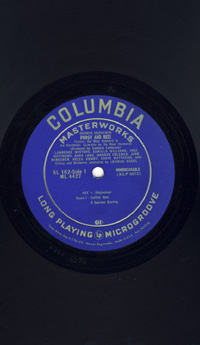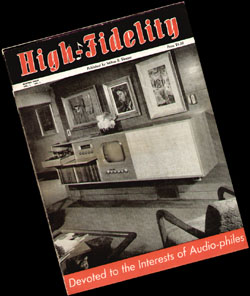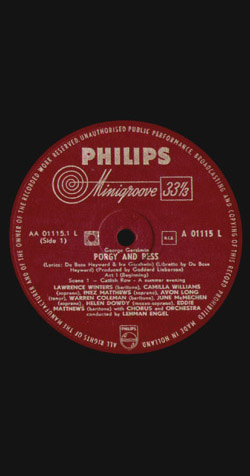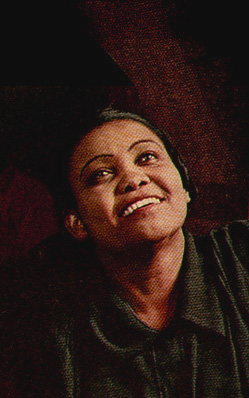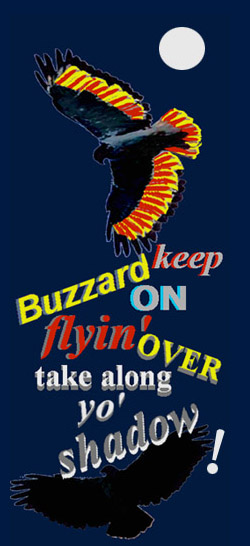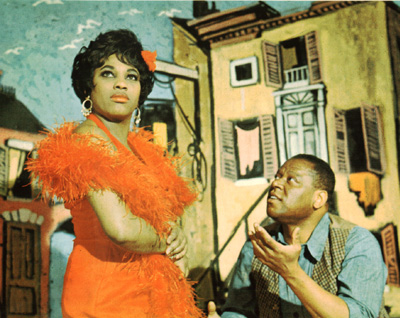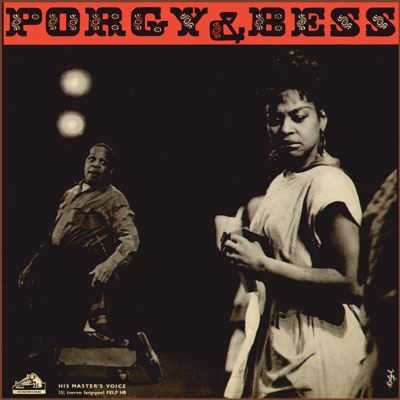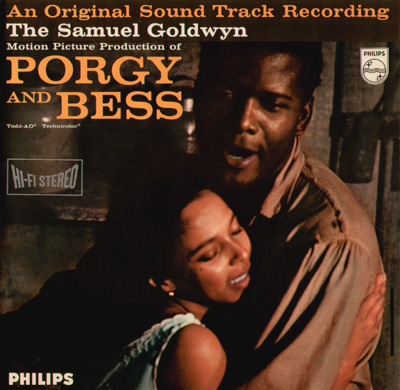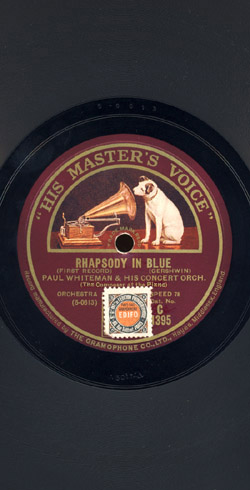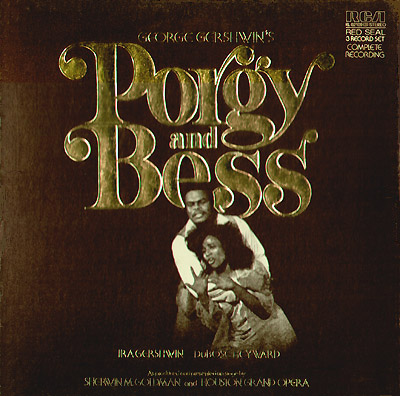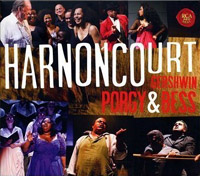|


Camilla
Williams singing Bess in the most famous recording of Porgy & Bess
in 1951. The picture was taken from the pages with notes in the original
Columbia 3 Lp box.
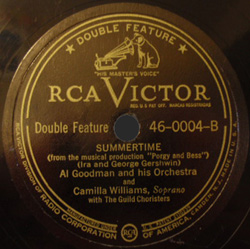
Camilla
Williams had already sung Summertime on the B Side of RCA Victor
V-46-0004, a 78 RPM shellac disk from 1947, with Al Goodman and his
Orchestra and The Guild Choristers. The label says "from the musical
production". On Side A there is an adaptation of Rhapsody in Blue
with pianist Vladimir Sokoloff.
(Image and sound sample provided by Sophia Hsu, USA)
|
THIS PAGE
The late Mrs. Laszlo Halasz (cellist
Suzette Forgues, before she married the conductor who founded the New
York City Opera Company), told me the story of soprano Camilla Williams
singing Cio Cio San in Madame Butterfly (Puccini, 1946). After I had
published this recollection of a remarkable event on  The Remington
Site in November 2000, I received an e-mail from a gentleman
friend of Camilla Williams who had told the soprano about it. Camilla
Williams sang Bess in the first "complete" recording of George
Gershwin's great opera, conducted by Lehman Engel and produced by Goddard
Lieberson for Columbia Records in 1951. And while I had a page about
Porgy and Bess in mind, she would love to give more details and information
and would authorize me to publish a page about Camilla Williams herself.
The Remington
Site in November 2000, I received an e-mail from a gentleman
friend of Camilla Williams who had told the soprano about it. Camilla
Williams sang Bess in the first "complete" recording of George
Gershwin's great opera, conducted by Lehman Engel and produced by Goddard
Lieberson for Columbia Records in 1951. And while I had a page about
Porgy and Bess in mind, she would love to give more details and information
and would authorize me to publish a page about Camilla Williams herself.
That was in 2000 when I had started the project about the nineteen fifties
label Remington Records and gave it a sort of encyclopedic form which
is the same today as it was then. However separate individual pages
about Porgy and Bess and about Camilla Williams never materialized as
after a computer crash all e-mails had been erased, addresses had 'evaporated'
and my good intentions had gone up in smoke. Remember, in those days
an external 500 Gigabyte hard disk to back up an entire system was non
existent.
No way to be able to establish the contact again.
Now, many years later, I have started to publish a page on Porgy &
Bess. It may seem rather pretentious as already so much has been written
by experts on George and Ira Gershwin, on Edwin DuBose Heyward and his
wife Dorothy, about the people involved in the first production, how
George Gershwin himself did the casting of the (main) characters and
the chorus for the premiere in Boston in 1935... so much has been written
and said, that there would hardly be anything left to report on.
But as a record collector - I grew up with Gershwin's music as did so
many of my generation - I thought that it would be interesting to give
a round up of recordings, to publish details, and to show a few memorabilia,
connected to the opera and the artists. Especially because there is
the complete original, lengthy 1935 score version available now on CD,
recorded by Decca, released in 2005. You will have to judge about that
performance for yourself.
I will add ad lib and at random. You will understand. This page is dedicated
to Camilla Williams and to all the Besses, but also to all the Porgies,
Serenas, Sportin' Lifes, Crowns and Marias, and all those who contributed
to the fantastic performances in theatres and on recordings.
 Click
here for a sample of Camilla Willams singing Summertime in 1947.
Click
here for a sample of Camilla Willams singing Summertime in 1947.
|
|
2010:
75TH ANNIVERSARY OF PORGY & BESS
"To
celebrate the 75th anniversary of George Gershwin’s enduring
masterpiece, a new production of Porgy and Bess is being
mounted—with the full approval of the Gershwin estate—by
veteran opera producer Michael Capasso (General Director of New
York’s vibrant Dicapo Opera), produced in association with
Willette Murphy Klausner. (More details will be published
later at the end of this page.)
|
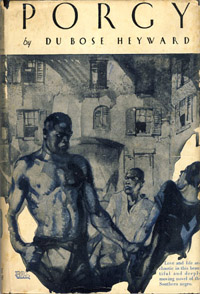
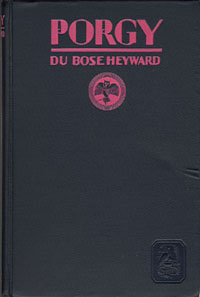
Dust
jacket and knicked hard cover from 1925.
|
|
|
EDWIN DUBOSE HEYWARD
Porgy,
the novel, was written by Edwin DuBose Heyward. He lived in Charleston,
South Carolina. When he fell ill with polio, he started writing poetry
and later prose. I edited his picture, taken from the back of the somewhat
stained dust cover of the book, published by Grosset & Dunlap, New
York, by arrangement with George H. Doran Company, Copyright 1925. DuBose
Heyward was in his thirties when he wrote his masterpiece and 39 when
it was first published. I bought the book in an antique book store.
|
 |
|

|
THE
PLAY
Dorothy and Edwin DuBose Heyward turned
the novel into a play. It was first staged in October 1927. The play
was to be the basis for the libretto.
|
|
|
In National Geographic, Volume 172, No. 6,
December 1987, an article appeared with the title "Sea Change in
the Sea Islands - Nowhere to Lay Down Weary Head". The article was
written by Charles L. Blockson, based on material collected by
the late Patricia Jones-Jackson who lived intermittently for 13
years in the Sea Islands of South Carolina.
The article tells about the history, the changes, the customs and the
language. It is critical on the interference and exploitation of the culture.
In it you will find the word "buckra" for "white man"
and a map suggests that Kiawah Island must have become Kittiwar
in DuBose Heyward's novel and Kittiwah Island in George Gershwin's
opera.
|
CRITICAL
ASSESSMENT
Reading
the novel is not too easy, at least at first sight. It initially asks
for a lot of concentration because of the writing of the spoken language,
no matter if it is a true rendition of the Gullah language or not. This
is not a criticism. There are other aspects of the novel, the play and
the opera, which have been criticized by several people. These aspects
are about ethics, about the distortion of the originality of the characters
that really have existed, and the way the play and the opera have been
"exploited" right from the early days on. You may read the
assessment written by  Kendra
Hamilton: 'I grew up in Charleston, South Carolina'.
Kendra
Hamilton: 'I grew up in Charleston, South Carolina'.
It is good to view Porgy & Bess from a different perspective.
Her criticism is partly of a technical nature. The question is: Were
the facts distorted? It is also a sociological issue: the disintegration
of society which was the result when Charleston became a tourist attraction.
There is also the feeling that "whites" came up with novel,
play and opera. (Duke Ellington apparently despised the work. Yet he
performed and recorded at least Summertime with singer Betty Roché,
and finally contributed to a 3 Lp jazzy version.) But to the true beholder
the white initiative seems less important in the end. Porgy & Bess
is a mirror to one's own soul, to everybody's soul. It is about the
vitality and the despair, the passion and the hope for a better life.
That is the universality of the story which became the folk opera.
Porgy and Bess is about the caring, the empathy and the love people
have for each other. It is also about the dangers the world has to offer.
|

The
cover of
National Geographic
Volume 172, No. 6,
December 1987
|
| |
THE MUSIC
The
score of the opera shows a rich and original orchestration. Songs, arias,
melodies are close to the spoken language and that is what it makes
so natural and is therefore easily accessible. There are remininescences
of spirituals and work songs. And there are a few leading motifs reminiscing
George Gershwin's visit to France and his meeting with Maurice Ravel.
(As there is in "An American in Paris" a reminder of Debussy's
"Par les rues et dans les chemins" - In the Streets and on
the Roads, the first part of "Images pour orchestre".)
|
|
|
Porgy
- Lawrence Winters - Baritone
Bess - Camilla Willams - Soprano
Serena - Inez Matthews - Soprano
Sporting Life - Avon Long - Tenor
Crown - Warren Coleman - Baritone
Clara - June McMechen - Soprano
Maria / Lilly / Strrawberry Woman -
Helen Dowdy - Mezzo Soprano
Jake - Eddie Matthews - Baritone
Mingo - William A. Glover - Tenor
Robbins - Irving Washington - Tenor
Peter - Harrison Cattenhead - Tenor
Frazier - J. Rosamund Johnson - Baritone
Annie - Sadie McGill - Mezzo Soprano
Jim - George Fischer - Baritone
Undertaker - Hubert Dillworth - Baritone
Nelson / Crabman - Ray Yeats - Tenor
Mr. Archdale - Robert Carroll
Detective - George Matthews
Policeman / Coronor - Peter van Zand
|
|
|
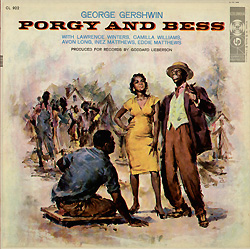
Highlights from the complete recording on Columbia CL 922. |
|
|
|
|
THE
COLUMBIA SET
The first "complete" recording was made by
Columbia. In the picture you see Lehman Engel and Goddard Lieberson.
Engel was the conductor and Lieberson the producer for the Columbia
recording. The edited images of Camilla Williams and of Lehman Engel
and Goddard Lieberson are from the accompanying notes of the original
Columbia SET SL-162 from 1951.
Though it was quite a long version, several cuts were made. There is
no Maria addressing Sporting Life who wants to be friends with her.
But there is of course the omen in the "Buzzard Song". For
that song one can also play the wonderfully dramatic and swinging concept
of Miles Davis and Gil Evans on Columbia LP CS 8085.
In
1968 the original 3 LP recording from 1951 was reissued on Columbia
OSL-162 and later on Odyssey 32 38 0018. Both were "electronically
re-channeled for stereo". The recording dates of course from 1951.
No full length commercial stereo recordings were made in the sixties
and early seventies.
In
High Fidelity Magazine Vol. 1, No. 3 (Winter, 1951) reviewer D.A. evaluated
the Columbia 3-LP set.
|

|
|
|
GERSHWIN:
Porgy and Bess
Lawrence Winters (bne), Camilla Williams (s), Inez Matthews (s), Warren
Coleman (bne), Avon Long (t) and cast. J.Rosamond Johnson Chorus, and
unnamed orchestra; Lehman Engel, cond. 3 Columbia 12-in. Set SL 162.
2 hrs. 9 mins.
"Another
feather in Columbia's operatic cap.
The rapid growing library of complete operas opens endless new vistas
to music lovers unable to attend live performances. Porgy and Bess is
a case in point. For so many, it has been a work read about in the Sunday
theatre sections of metropolitan newspapers, and heard only in snatches
of particularly popular songs. Now for the first time, anyone with even
an inexpensive LP record-player attachment can hear all of Porgy and
Bess and will, no doubt, find many a song or melody which will become
better loved than some of those previously in the record library. (...)
The man with a hi-fi listening system will be rewarded indeed, for the
sound on these discs is typical of what can be done when a record manufaturer
decides to do its best. And this best can be, today, wonderful to hear.
(...)
Columbia is also to be congratulated on a very deft handling of sound
effects. These sounds - walking, doors closing, coins dropping - are
held to naturelness; the stage is not suddenly stilled, a door slammed
with a crash, and then the actors brought back to life again."
|
|
Period
SPL 580: Inez Matthews sings Spirituals accompanied by Jonathan Brice
at the piano.
|
INEZ
MATTHEWS
Mezzo Soprano Inez Matthews sang the role of Serena. Her beautiful voice
was also preserved on Vol. 6 of the Great Voices of Today Series.
Inez Matthews made her debut in New York's Town Hall when she was still
in high school. One critic wrote: "A rare and luminous talent".
In
the June 1954 issue of High Fidelity Magazine, John M. Conly reviewed
the recording Inez Matthews sings Spirituals (Period SPL 580).
What he wrote is a precise description of the voice and personallity
of Inez Matthews, but now, some 55 years later, it can be read as a
tribute. Mr. Conly wrote:
"While
still very young she was selected to sing the lead in Billy Rose's Carmen
Jones. Then she got the feminine lead opposite Todd Duncan in the
Kurt Weill-Maxwell Anderson production Lost in the Stars. Goddard
Lieberson choose her as the Serena in his uncut Columbia Porgy
and Bess, and Virgil Thomson made her St. Therese I in his
revival of Four Saints in Three Acts. Miss Matthews won them
through a liberal application of brains, a brilliant feeling for drama,
a natural vocal limpidity and a trick of delivery, sparingly used, hard
to describe but equally hard to resists, a sort of educated scoop which
invests her full voice with a remarkable sobbing quality. In these spirituals
it is electrifying. It is also exactly right. I know of no record so
convincing or so moving as this one. To put yourself to the test, hear
her sing Balm in Gilead, and feel the history in it. The recording is
for its purposes, practically perfect, intimate and high in level."
Edward
Matthews was her brother and teacher. He was Jake the Fisherman
in the Columbia production of Porgy and Bess and he was St.
Ignatius in Four Saints in Three Acts. Conly ends his review
on a very sad note: "The week this record was issued his car skidded
off a Virginia highway. He was killed."
|
|
| |
|
|
| |
LAWRENCE
WINTERS
Lawrence Winters who studied with Todd Duncan sang Porgy
in the 1942 revival. Then he was hired by Laszlo Halasz (New York City
Center Opera) and in 1951 he was Porgy in the Goddard Lieberson production.
He later went to live in Germany, Europe.
|
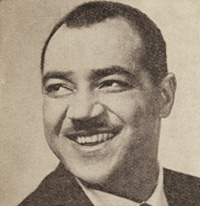
Lawrence Winters
Photograph taken from the liner notes of Columbia SL 162 - 3 LP Set
from 1951
|
|
|
|
Philips
Minigroove issue of Columbia's recording
|
|
|
PORGY
AND BESS ON PHILIPS
In Europe the complete 3 Lp Set of the 1951 recording
was released by Philips in a book with a yellow spiral coil at the spine,
the way Philips bound complete sets of operas like Richard Strauss's
Salome with soprano Walburga Wegner and conductor Rudolf Moralt, and
I Pagliacci with Richard Tucker and the Metropolitan Opera conducted
by Fausto Cleva.
Around 1953 the
Dutch record company Philips (known as Philips Phonografische Industrie,
in short PPI), made a deal with Columbia Records which became effective
in the spring of 1954. Columbia licensed their recordings to Philips
(and no longer to EMI) for release on the Philips label. These were
recordings ranging from Bruno Walter, Dimitri Mitropoulos, Rudolf Serkin,
and Zino Francescati, to Benny Goodman, Duke Ellington, Erroll Garner,
and the Rampart Street Paraders. Original Philips recordings were released
in America on the Epic label, a sub label of Columbia. A few recordings
were issued as a Columbia release like Mengelberg's St. Matthew Passion.
Some other recordings were made in cooperation. Like the Robert Cassadesus-Eduard
Van Beinum recording of Beethoven's Piano Concerto No. 4 which also
appeared on Columbia instead of Epic. This became evident when in 1961
the deal was ended and Philips bought the Chicago based Mercury Records.
When CBS started to market their recordings in Europe themselves the
CBS release of this concerto was pressed from the original Philips HiFi-Stereo
plates instead of plates cut by the Columbia engineers. More CBS records
were pressed from original Philips HiFi-Stereo matrices or from Fontana
Full Stereo plates like Dave Brubeck's album Gone With The Wind.
|

Most
images of covers, artists and labels have been scanned from items in
my own collection.
|
|
|
|
|
|
|

|
 |
Porgy
& Bess on 78 RPM:
Anne Brown (Soprano), Todd Duncan (Baritone), Eva Jessye and her Choir,
Avon Long, and members of the original New York production, with the Decca
Symphony Orchestra, Alexander Smallens.
DECCA "Persopnality Series"
3 Volumes - 6 Sides.
Vol. I 4x 12" D-A145
Vol. II 3 x 10" D-A283
Vol. III 3 x 10" D-A351Pictures
from the original 1942 Decca album D-283.
|

|
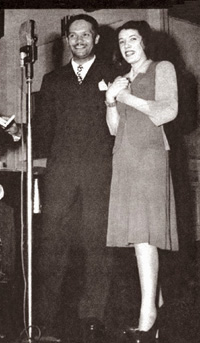
Anne
Brown and Todd Duncan in front of the microphone.
|
|
|
ALEXANDER SMALLENS
The
first performance of Porgy and Bess was in the Colonial Theater in Boston,
on September 30, 1935. It was presented by the Theater Guild. The opera
was far too long. It took hours and hours to come to an end. The costly
production was directed by Rouben Mamoulian. The settings were by Sergei
Soudeikine, and the orchestra was conducted by Alexander Smallens. After
the problematic staging in Boston, the production went to New York,
to show in the Avalon Theater.
Like George Gershwin, Alexander Smallens was of Russian descent but
had come to the US as a young child, whereas Gershwin was born in Brooklyn.
For many years Alexander Smallens was the best advocate of George's
masterpiece. He conducted highlights in 1942, released on several 78
RPM shellac records. These were later transferred to Lp: Decca DL 9024.
Smallens was also the conductor of excerpts of the opera recorded by
Victor.
|

Alexander
Smallens conducted the first performance of Gershwin's Porgy & Bess
|

Anne
Brown sings Summertime and My Man 's Gone Now on Tono X 2512 from around
195. Det kongelige Kapel og Kor. Dirigent: Joh. Hye-Knudsen.
|
ANNE BROWN AND SUMMERTIME
According
to the Internet Movie Data Base Anne Brown sang Summertime in the Gershwin
biopic Rhapsody in Blue in 1945. A few years later - in 1948 - she settled
in Oslo and became a Norwegian citizen. She remained the very creative
and imaginative artist that she was and performed in many European cities.
It was she who had suggested to George Gershwin to insert "Summertime"
later in the opera for Bess to sing, illustrating how much she loved
that song sung by Serena at the beginning right after the Overture.
That is what George did. In Norway Anne Brown recorded "Summertime"
for the TONO label on 78 RPM shellac on the B-Side. And on Side One
she sang "My Man 's Gone Now". She was accompanied by the
Royal Orchestra and Chorus conducted by Johan Hye-Knudsen, or in Danish:
Det kongelige Kapel og Kor, Dirigent: Joh. Hye-Knudsen. The reference
number of the disc is X 2512. (I will add an audio clip later.)
|
|
|
On
Victor appeared recordings of selections of the opera, supervised by
George Gershwin himself.
VICTOR 78 RPM::
Helen Jepson (Soprano), Lawrence Tibbett (Baritone), Orchestra conducted
by Alexander Smallens. This recording was supervised by George Gershwin.
4x 12" V-C25
|
SUPERVISED BY GEORGE
GERSHWIN
It
was decided that the opera should be performed on stage by an all black
cast, with the exception of the detective. Yet many a singer recorded
one or more songs or arias. In this respect it is a curiosity that George
Gershwin himself supervised the Victor recording with American Baritone
Lawrence Tibbett singing the role of Porgy: Oh, I got Plenty
o' Nuttin', Buzzard Song, Bess, You Is My Woman Now. The recording dates
are October 14 and 23, 1935, only two weeks after the Boston premiere
on September 30 1935.
More white artists have sung selections: Eleanor Steber (Sumertime,
1/15/1946), Robert Merrill (A Woman Is a Sometime Thing, Bess,
Oh Where's My Bess, Oh Lawd, I'm on my way, 9/12/1950), Risë
Stevens (My Man's Gone Now, 9/13/1950). On that same lp reissue
(RCA AVM1-1742) there is also a selection sung by Cab Colloway:
It Ain't Necessarily So (5/5/1953).
|

RCA
Victrola AVM1-17422 (issued in 1976).
|
|
|
IRVING KOLODIN
Irving
Kolodin is one of the most well known critics from the nineteen forties
and fifties and sixties. He evaluates several performances in The
New Guide To Recorded Music which Kolodin prepared at the end of
the nineteen forties and was published in 1950 (Double Day and Company).
Naturally this guide deals mostly with 78 RPM shellac records and just
a few long playing records, mostly dubbings from earlier shellac recordings.
This is what he says about recordings available at the time.
Summertime
- "There can be little doubt that the most colorful and understanding
of these performances is Anne Brown's, sounding as it did when she created
the part of Bess. Steber sings with exceptional beauty of sound and
a lovely lyric sympathy that are quite thrilling; moreover against an
orchestral background distinctly superior to those provided for Brown
and Jepson."
I
got Plenty o' Nuttin - "Duncan has both the voice for this
music and the style to utilize it fully."
Bess
You is My Woman Now: "Better by Jepson and Tibbett than Brown
and Duncan."
It
Ain't Necessarily So - Kolodin can not endorse the performances
by Avon Long, nor Lawrence Tibbett and Paul Robeson in the role of Sportin'
Life. They do not match the performance which John Bubbles gave in the
original production of Porgy and Bess in 1935 which Kolodin, then 27,
must have attended. He finds Avon Long to be an affected and self-conscious
performer.
It is just that trait which gave producer Goddard Lieberson the idea
to have Avon Long sing Sportin' Life in the 1951 Columbia recording.
Lehman Engel certainly had a different concept of Sportin' Life in mind
than Alexander Smallens would allow and Engel gave Long the artistic
space for a memorable performance. From then on every Sportin' Life
was measured against Avon Long's "teasing and slimy" Sportin'
Life.
|
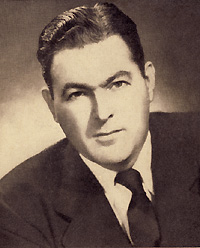
Critic,
reviewer, musicologist
Irving Kolodin
|
| |
|
|
|
Leontyne
Price and William Warfield
Picture from the RCA Lp release with highlights of Porgy & Bess.
|
|
|
|
|
TOURING
THE USA AND EUROPE
Alexander
Smallens was also the conductor of the revival performances in the nineteen
fifties. These were of the adaptation of the opera to make it - as a
sort of musical - easily accessible. The first production, Blevin Davis
and Robert Breen were the producers, toured the States and returned
to open at the Dallas State Fair, on June 9, 1952. The production visited
Chicago, Pittsburgh, and Washington, D.C., and then went on tour in
Europe (sponsored by the US State Department) and performed in Vienna,
Berlin (Titania Palast), London, and Paris (Salle Wagram). This production
was also showed in the Ziegfeld Theater (Broadway). That was the production
in which William Warfield was Porgy, and Bess was the young star, Leontyne
Price. The picture of Leontyne Price and William Warfield is from the
RCA Lp release with highlights.
|
|
Leontine
Price - Bess
William Warfield - Porgy
Cab Calloway - Sportin' Life
John McCurry - Crown
Helen Colbert - Clara
Jerry Laws - Mingo
Helen Thigpen - Serena
Joseph James - Jake
Howard Roberts - Robbins
Leslie Scott - Jim
Joseph Crawford - Peter
Helen Dowdy - Lily
Georgia Burke - Maria
Catherine Ayers - Annie
Sam Kasakoff - Policeman
Walter Riemer - Detective
William Veasey - Mortician
Moses LaMarr - Frazier
Elizabeth Foster - Ruby
Ray Yeates - Crab man
Willis Daily - Policeman
Choir production Eva Jessye
Choir of the Blevins Davis & Robert Breen Production
Alexander Smallens - Conductor |
|
|
| |
|
|
| |
THE SECOND
TOUR TO EUROPE
During
the second tour of the Blevin Davis and Robert Breen production of Porgy
and Bess in Europe, the group also came to the Netherlands, to Amsterdam,
to perform in the Carré Theater on the Amstel River in the center
of the city. In 1956 that was. And again Alexander Smallens was
the conductor. Assistant conductors were Dalibor Brazda and Joseph
Lewis. Scenery was by Wolfgang Roth and costumes were by
Jed Mace.
|
|
|
Porgy
1- LeVern Hutcherson - Baritone
Porgy 2 - Leslie Scott - Baritone
Porgy 3 - Irving Barnes - Baritone
Bess 1 - Martha Flowers - Soprano
Bess 2 - Ethel Ayler - Soprano
Serena - Helen Thigpen - Soprano
Sporting Life 1 - Lorenzo Fuller - Tenor or
Sporting Life 2 - Joseph Attles - Tenor
Crown 1 - John McCurry - Baritone
Crown 2 - Al Hoosman - Baritone
Clara - Joy Mc Lean - Soprano
Jake 1 - Irving Barnes - Baritone
Jake 2 - Joseph S. Eubanks - Baritone
Mingo 1 - Jerry Laws - Tenor or
Mingo 2 - George Royston - Tenor
Robbins - Ned Wright - Tenor
Peter - Merritt Smith - Tenor
Frazier - Mozes LaMarr - Baritone
Annie 1 - Catherine Ayers - Mezzo Soprano
Annie 2 - Catherine Van Buren - Mezzo
Dancing Ruby - Leesa Foster - Mezzo
Jim - Alfred Thomas - Baritone
Undertaker - William Veasey - Baritone
Strawberry Woman - Helen Furguson
Nelson - Lawson Bates - Tenor
Crabman - Lawson Bates - Tenor
Mr. Archdale - Sam Kasakoff
Detective - Julio Ruiz-Gonzales
Policeman / Coronor - Peter van Zand
|
|
Three
times Porgy: Baritones LeVern Hutcherson, Leslie Scott,
and Irving Barnes.
|
This is the Dutch program of the Second Tour to Europe
in 1956. It reads: H.E. the Ambassador of the United States of America,
The International Clearing House for Cultural Exchanges (Brussels),
and the International Theater Institute (UNESCO), present the Blevin
Davis and Robert Breen production of Porgy and Bess.
|
|
Two
times Bess:
Sopranos Martha Flowers
and Ethel Ayler.
|

Leslie
Scott was asked by "Philips' Phonographische Industrie" in
Baarn, Netherlands, to make a recording with Jan Corduwener and his
Radio Orchestra. The disc was released under the title Leslie "Porgy"
Scott, Reference Philips P 13015 R.
Eight
selections were issued:
On
Side One: Over the Rainbow - Love Is Here To Stay - All The Things You
Are - Thanks For The Memory
On
Side Two four Negro Spirituals were engraved: When I Fall On My Knees
- Swing Low, Sweet Chariot - Go Down, Mozes - Were You There
|
|
At
left the liner notes of Philips P 13015 R which are worth reading. They
are testimony of how well 'Porgy and Bess' was received, how the artists
were appreciated, and how the recording session for Leslie Scott's disc
were experienced. The author of the linernotes writes:
Europe
had never been treated to a musical play like this before... And it was
there we heard him for the first time: Leslie Scott as Porgy... Crippled
Porgy ... What a voice... What an artist.
|
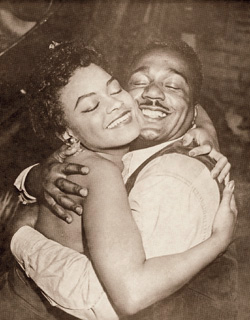
Martha
Flowers and Leslie Scott
At
the far right: Lorenzo Fuller and Joseph Attles.
|
Traveling
from one country to another and performing nearly every night was a
heavy burden for all involved. Porgy's role is extra demanding while
he has to be on his knees when on stage. Therefore three singer/actors
were cast to play Porgy: Baritones LeVern Hutcherson, Leslie Scott,
and Irving Barnes. (Irving Barnes had taken his wife Catherine and daughter
Gail with him on tour.)
And for the role of Bess there were two sopranos: Martha Flowers and
Ethel Ayler.
There
were two performers for Sportin' Life, Lorenzo Fuller and Joseph Attles;
two for Jake, Irving Barnes (when he was not playing Porgy) and Joseph
S. Eubanks; and two for Crown, John McCurry and Al Hoosman.
Time
Magazine reported in February 1956 that the same production went to
Russia as well, though not subsidized by the State Department. However
a lot of goodwill was the result.
Wherever the production came to perform, tickets were practically always
sold out.
Lorenzo
Fuller, Jr. was born in 1919 in Stockton, Kansas and died on January
8, 2011 at the respectable age og 91 in New York City, New York. He
attended the University of Kansas and while a student had a monthly
program on KFKU radio. He received a fellowship to attend the Juilliard
School of Music in 1946. Fuller held roles in Broadway plays such as
Finian's Rainbow and Kiss Me Kate, and appeared on radio shows in the
1940s. He is considered to be the first African American to host a national
television show—a 15-minute show on NBC in 1947. Data taken from
the  Kansapedia
website.
Kansapedia
website.
|
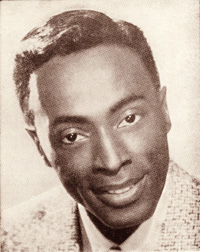
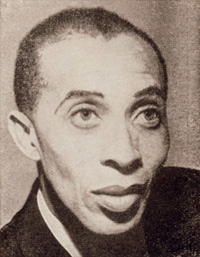
|
|
The selections:
Summertime (Martha Flowers): A woman is a sometime thing (Irving Barnes),
My man's gone now (Leesa Foster), Oh, I'm going out to the Blackfish Banks
(Irving Barnes and Chorus), I got plenty of nuttin' (Irv ing Barnes and
chorus), Bess, you is my woman now (Irving Barnes and Leesa Foster), Oh,
I can't sit down and It ain't necessarily so (Joe Attles and chorus),
Oh, doctor Jesus (Leesa Foster), Strawberry woman (Martha Flowers), There's
a boat that's leavin' soon for New York Lorenzo Fuller), Bess, oh where's
my Bess (Irving Barnes), Oh, lawd I'm on my way (Irving Barnes and chorus).
|
|
The
charm of a performance by a touring company.
Martha
Flowers - Soprano
Leesa Foster - Mezzo Soprano
Irving Barnes - Baritone
Joe Attles - Tenor
Lorenzo Fuller - Tenor
With
Symphony Orchestra and Chorus "Concerthall Haarlem", conducted
by Lorenzo Fuller.
Cover
of the original Dutch HMV release FELP 148.
|
|
|
EXCERPTS RECORDED IN
HAARLEM, THE NETHERLANDS
Because of the great success of the performances
in the Carré Theatre in Amsterdam, it was arranged that members
of the production were to record excerpts in the Haarlem Concertgebouw
(today Philharmonie Haarlem) with the so-called Concerthall Haarlem
Symphony Orchestra and Chorus - musicians and voices hired for the occasion.
The recording was produced by N.V. Bovema, the Dutch distributor of EMI
in the town of Heemstede, and was taped on Friday, June 1st, 1956. Instead
of Smallens or one of the two assistant conductors, Lorenzo Fuller
was the conductor. And he was an enthousiastic one. Alexander Smallens
was probably under contract with another record company and to get permissin
on short notice was impossible. Or, the recording was done on the instigation
of the performers and Bovema, bypassing the producers of the tour. It
was a low budget recording and a quick fix which is shown by the somewhat
unprofessional microphone placement. Yet Martha Flowers sings with her
clear and transparent voice a beautiful Summertime and she is an expressive
Strawberry Woman. Leesa Foster is Bess, regrettably with some rather unstable
singing. Barnes, Attles and Fuller are quite good. It remains a memorable
document.
The recording was distributed in more countries. In France on La voix
de son maitre (FALP 30198) and in England on the Music for Pleasure
label. It was even available in the DDR, the former German Democratic
Republic (GDR) on Eterna 820 432 in a series entitled "Musikalische
Kostbarkeiten" (Musical Treasures).
|
|
|
|

|
Lorenzo
Fuller conducting the Haarlem Concertgebouw Orchestra and Chorus
(Image
taken from the cover of the original Dutch HMV recording FELP 148.
At
far left the EMI Music for Pleasure release: MFP 1154.
|
|
|
When
on Cadence LP CLP 1004, entitled Piano Perspectives, magnificent pianist
Don Shirley starts playing "I can't get started", his introduction
reminds one of I loves You Porgy. Don Shirley knows every brand and
style. His improvisations shift easily from jazz to popular to classical.
That is why Ravel unexpectedly turns up on CLP 1004. And Rachmaninoff
shines through on Cadence CLP 25055 "Don Shirley Presents Martha
Flowers". This record is also a grand introduction to Don Shirley
himself, to his elaborate technique, subtle swinging and inspired harmonies.
It is an introduction for all those people who did not get acquainted
with this phenomenon from the nineteen fifties and sixties. The first
side of the LP (with songs by Victor Young, Richard Rogers, Harold Arlen,
R. Bloom, and George Gershwin) was recorded on August 6, 1962 by engineer
John Quinn. The Porgy and Bess Suite on Side Two was recorded much earlier,
on October 19, 1960, by famous recording technician George Piros.
Both recordings were made at Fine Recording Studios, New York City,
and have all the traits of a perfect C. Robert Fine production.
Martha Flowers sings - accompanied by Shirley and a cello and string
bass player - the songs she did so well on the Dutch recording made
6 years earlier: Strawberry Woman, and an ever so compelling Oh, Doctor
Jezus. - R.A.B.
|

Martha
Flowers with Don Shirley with bass player Ken Fricker and cellist Juri
Taht. Their names are not mentioned on the cover.
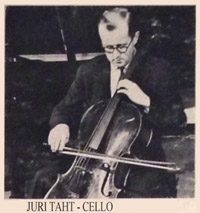
|
|
History
of Performances:
1935: September 30, Premiere
in Boston
1935: October 10, first performance in New York
1938: Performances in Los Angeles and San Francisco
1941: Performances of abridged version in New Jersey
1942: Performances of abridged version in New York
1943: First European staging in Copenhagen, initiated by Ann Brown
1945: performances in Moscow
1949: Sweden
1952: New production: Dallas, Chicago, Pittsburg, Washington
1952: Same production visits Vienna, Berlin, London and Paris,
then back to New York
1953: Second tour to Africa, Spain, Itraly (La Scala), Poland,
Tchechoslowakia, Netherlands (The Hague and Amsterdam Carre Theater)
1958: Performances at Melody Fair at Wurlitzer Park, North Tonawanda.
Lewis T. Fisher, producer. With Urylee Leonardos, Martha Flowers, Andrew
Frierson, John Bubbles, John McCurry.
1959: Film poduction in Cinemascope
1961: New York City Center Opera Company. Julius Rudel conducting;
with Martha Flowers Leesa Foster, William Warfield and Irving Barnes
1962: New York City Center Opera Company. Julius Rudel conductinmg;
with Lawrence Winters and Leesa Foster
1965: Production of the original 1935 New York version in Vienna
by Marcel Prawy.
1976: Houston Grand Opera
1978: New production visits Europe
1987: Production by Dutch Radio VARA (Matinee production)
2008: Production visits Amsterdam Royal Carre Theater
|

Sketch
of the set of the production of the second tour.
A=Lilly
and Peter B=Porgy and Bess
C=Jake and Clara D=Jim E=Mingo
F=Serena Robbins G=Maria
H=Ruby I=Frazier
J=Annie K=Sportin' Life
|
|

Marcato
78.113
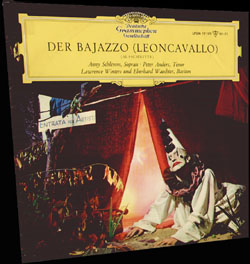
Deutsche
Grammophon Gesellschaft LPM 19 199
|
LAWRENCE WINTERS
After his success in the 1951 Columbia recording
Lawrence Winters sang together with Patricia Neway, Frances Bible, Mark
Harrell, and the  New
York City Opera under Joseph Rosenstock in Dybbuk, one of the
successful opera productions during the rule of Laszlo Halasz. In the
nineteen fifties he also sang the part of Daniel in the one-act opera
The Devil And Daniel Webster composed by Douglas Moore, recorded by
Westminster. After he had gone to live in Germany in 1959, he recorded
I Got Plenty Of Nuttin, It Ain't Necessarily So, September Song, together
with Ol' Man River and other songs, for German Philips 843 741 PY.
New
York City Opera under Joseph Rosenstock in Dybbuk, one of the
successful opera productions during the rule of Laszlo Halasz. In the
nineteen fifties he also sang the part of Daniel in the one-act opera
The Devil And Daniel Webster composed by Douglas Moore, recorded by
Westminster. After he had gone to live in Germany in 1959, he recorded
I Got Plenty Of Nuttin, It Ain't Necessarily So, September Song, together
with Ol' Man River and other songs, for German Philips 843 741 PY.
On Philips 838 903 SY he sang together with Anabelle Bernhard
excerpts from Porgy and Bess in German(!), with the NDR Radio Orchestra
(Rundfunk-Orchester) conducted by Richard Müller-Lampertz.
The British conductor, bandleader and composer Kenneth Alwyn
is known for the first release in Decca's Full Frequency Stereo Sound
catalog, SXL 2001 Wide Band Label, conducting the London Symphony Orchestra
in Tchaikovsky's 1812 Festival Overture (Overture Solennelle).
Lesser known is his rather trivial arrangement of selections from Porgy
and Bess which he recorded with the New World Show Orchestra. Singers
were Lawrence Winters, Isabelle Lucas, Ray Ellington, Barbara Elsy,
Pauline Stevens, and the Linden Singers. This recording was released
on various labels like Marcato (78.113) and Imperial (ILW 513). At left
the cover of the Marcato release. It is copied from the original recording
with Lorenzo Fuller conducting on His Master's Voice FELP 148, the lower
orange strip was there to cover the HMV logo.
Did Lawrence need the money? Probably, otherwise he would not have sung
the excerpts supported by such an orchestration.
Lawrence Winters was engaged at the Hamburg State Opera. He can be heard
on various records. He sang in Nabucco under the baton of  George
Singer. On Deutsche Grammophon Gesellschaft LPM 19 199 with
excerpts of Il Pagliacci (Leoncavallo) he sang with Anny Schlemm, Peter
Anders, and Eberhard Waechter. Winters was born in Kings Creek (USA)
in 1915. He died in 1965 in Hamburg, Germany. The picture of Lawrence
Winters at right was taken from the record cover of the Philips release
In Memoriam Lawrence Winters.
George
Singer. On Deutsche Grammophon Gesellschaft LPM 19 199 with
excerpts of Il Pagliacci (Leoncavallo) he sang with Anny Schlemm, Peter
Anders, and Eberhard Waechter. Winters was born in Kings Creek (USA)
in 1915. He died in 1965 in Hamburg, Germany. The picture of Lawrence
Winters at right was taken from the record cover of the Philips release
In Memoriam Lawrence Winters.
|
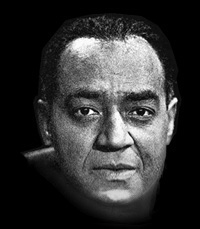
Lawrence
Winters
|
| |
|
|
| |
Another
recording with a lot of good intent is the performance of highlights
conducted by Paul Belanger with singer/actor Brock Peters, sopranos
Margaret Tynes, Miriam Burton and Theresa Merritte, with tenor Joseph
Crawford, and baritones William Dillard and Charles Colman. The Opera
Society Chorus and Orchestra are of course fake names. The Opera Society
/ MMS 2035, not recorded in the Netherlands. For Brock Peters, already
a well known actor, it was the prelude to his strong performance of
Crown in Otto Preminger's movie.
|
|
|
|
Edward Jablonski
and Lawrence D. Stewart wrote 'The Gershwin Years' - The Story of George
and Ira Gershwin - for a long time the standard work on the brothers
and an abundant source for anyone writing about these great Americans.
The
good reception of this book in 1958 inspired musicians and producers
in recording more Gershwin compositions. George Bassman, who
had been additional music arranger for the movie 'A Damsel In Distress'
(1937) and
for Lady Be Good (1941), recorded selections from Lady, Be Good, Tip-Toes,
Oh, Kay!, Funny Face, Rosalie, Treasure Girl, Show Girl, Strike Up The
Band, Girl Crazy, Of Thee I sing, Pardon My English, Let'Em Eat Cake,
Shall We Dance, A Damsel In Distress, The Goldwin Follies, and....Porgy
And Bess: Introduction, Summertime, There' A Boat Dat's Leavin' Soon
For New York, Bess You Is My Woman Now. It was a 3 LP set - Decca DXSZ-7160.
Singers were Paula Stewart, Richard Hayes, and Lynn Roberts.
At that time the
movie was in production to be released in 1959.
|
|
|
Director
- Otto Preminger
Camera - Leon Shamroy
Musical Supervision - Andre Previn
Chorus Master - Ken Darby
Sets - Oliver Smith
Costumes - Irene Sharaff
|
|
The
original release of the sound track was on Columbia OS 2016.
|
| |
SAMUEL GOLDWYN'S
FILM
The public had to wait for the first stereo recording
till 1959 when Samual Goldwyn's lengthy movie 'Porgy And Bess' was released,
starring Sidney Poitier and Dorothy Dandridge. The movie was very popular
and despite the criticism was an instant success, at least in the town
where I lived.
|
|
|
|
|
Philips
released the sound track of the movie with Sidney Poitier and Dorothy
Dandridge in a beautifully styled gatefold record cover with plenty of
pictures and notes inside. Already then it was a collector's item for
moviegoers. The musical performance was conceived to appeal to a large
audience. It was supervised by pianist-conductor Andre Previn. Philips
HI-FI STEREO 840 033 AY.
|
|
Porgy
- Sidney Poitier (Voice of Robert McFerrin)
Bess - Dorothy Dandridge (Voice of Adele Addison
Serena - Ruth Attaway (Voice of Inez Matthews)
Sporting Life - Sammy Davis Jr. (Cab Calloway
Crown - Brock Peters
Clara - Diahann Carroll (Voice of Julie Jean Norman)
Jake - Leslie Scott
Mingo - William A. Glover - Tenor
Robbins - Joel Fluellen
Peter - Clarence Muse
Frazier - Roy Glenn
Annie - Everdinne Wilson
Strawberry Woman - Helen Thigpen
Mingo - Earl Jackson
Lillie - Margetret Hairston
Jim - Ivan Dixon
Undertaker - Maurice Manson
Nelson - Mozes La Marr
Detective - Claude Akins
|
|
 |
|
|
SAMMY DAVIS JR. &
CARMEN MCRAE
For
contractual reasons the voice of Sammy Davis Jr. could not be used in
the sound track and was dubbed by the voice of Cab Calloway. But Decca
made a recording with Sammy Davis Jr. together with Carmen McRae which
was released as Decca DL 8854. In the various selections the orchestra
was conducted by Jack Pleis, Buddy Bregman and Marty Stevens respectively.
At left the cover.
The
singing of Porgy (Sidney Poitiers) was done by Robert McFerrin. See
the page with  Trivia
at the IMdB website.
Trivia
at the IMdB website.
|
|
| |
WHERE IS THE MOVIE?
The film did not get the full approval from the Gershwin
estate and was only shown when it was first released and only on two occasions
in the years afterwards. Many people do criticise this as the movie is
an important chance for the youth of today to get into contact with Gershwin's
masterpiece and with his music in general. The slick and somewhat over-sentimental
approach of the performance in musical-style for the general public is
a far move from the original score, but many said "Who cares?"
See for more information  The
Passionate Moviegoer and read the disapproval by many in the forum
at IMdB.com.
The
Passionate Moviegoer and read the disapproval by many in the forum
at IMdB.com.
|
|
|
|
There
are however other recordings which should be criticised more than Otto
Preminger's Porgy & Bess of which the singing and the music were
supervised by pianist-conductor Andre Previn. One of those recordings
to be critical about is the ugly Kenneth Alwyn orchestration and other
obscure recordings like the Golden Tone High Fidelity recording of highlights
on C 4017, coupled with songs from Carousel. This last record contains
either bootlegged compilations or poor recordings of local performances.
And there are many more.
This showed all the more that the world has always been in need of a
good recording of the folk-opera.
|
|
| |
|
|
|
|
35 MM SOUND RECORDING
The
Command Classic 35 mm recording is special because of three things,
maybe four.
It is one of the recordings of the Symphonic Picture for Orchestra,
an arrangement written by Robert Russell Bennett. The Symphonic
Suite "Catfish Row" was written in 1943 and premiered in that
year by Alexander Smallens conducting the Philadelphia Orchestra. There
are a few other recordings of this orchestral suite, by Antal Dorati,
by Eduardo Mata, by Felix Slatkin, and by Andre Previn. It seems that
recording this score is gone somewhat out of fashion.
Well,
what is remarkable is that this Command Classic CC 11037 SD, is directed
by William Steinberg and played by the Pittsburg Symphony, the house
orchestra of the label at the time.
The performance is recorded by C. Robert Fine and Robert Eberenz, who
were responsible for so many outstanding  Mercury
recordings. Outstanding because of the microphone placement, the use
of 35 mm recording film and - last but not least - the way the lacquer
was cut by George Piros. Here it is also Piros who did the cutting.
Mercury
recordings. Outstanding because of the microphone placement, the use
of 35 mm recording film and - last but not least - the way the lacquer
was cut by George Piros. Here it is also Piros who did the cutting.
And finally there are two pictures on the cover. One of William Steinberg.
And one of Fritz Reiner (who is not conducting here, but he commissioned
the work), together with George Gershwin, Deems Taylor, and... Robert
Russell Bennett. It was taken in 1931, long before Porgy & Bess
was conceived. Robert knew George and he made several arrangements of
Gershwin shows in the 1930s.
|
|
| Morton
Gould made arrangements for his own Suite and recorded it in mono for RCA
together with An American in Paris. At right the edition issued in Germany
at the time by TelDec - LM-2002 C. |
|
|
|
|
|
Ethel
Aylor - in a lush photograph taken by Sam Kasakoff - adorns the cover
of Westminster Natural Stereo Balance WST 14063. Maurice Abravanel is
conducting the Utah Symphony. The Suite is coupled with Aaron Copland's
El Salón México.
|
|
|
Westminster
was the first record label to make a recording of the Suite of Porgy &
Bess created in January 1936 by George Gershwin himself which shows of
course authenticity, but also underlines the better concept of "Catfish
Row" from 1943, written by Robert Russell Bennett. After Gershwin
had died, the Suite remained in Ira Gershwin's family papers until Maurice
Abravanel proposed to make a recording. It was released in 1960. However...
There are always people who want to have the best seat in the theatre
for a dime. Not only they will find out that buying the cheap 10" Allegro
4114 recording of Gershwin's arrangement of the Porgy and Bess Suite played
by the Broadway Symphonic Jazz Orchestra directed by S. Auber is a bad
investment, but they may suspect that this Allegro disc may have been
made well before Maurice Abravanel did the recording for Westminster.
Another recording of the Suite appeared in 1974 on the East German Eterna
label and was played by the Gewandhaus Orchestra Leipzig, conducted by
Kurt Masur. The disc also containes An American in Paris and Cuban Overture.
Eterna 8 26 779.
|
|
| |
|
The
Grand Prix mono release from Pickwick International with yet another arrangement
or just part of the Suite from Porgy and Bess written by Gershwin himself.
On Side Two there is a fraction of Rhapsody in Blue, in fact the main theme.
These mutilated appearances are by John Senati and The Bravo Pops Symphony
Orchestra, if you don't mind. |
|
|
A
LONDON PHASE FOUR RECORDING
And
then there is the arrangement by the distinguished Canadian composer
and conductor Robert Farnon - as Decca/London puts it - who has undertaken
a completely new transcription of highlights from Porgy and Bess and
includes themes which cannot be found in the Robert Russel Bennett Suite.
Farnon's arrangement borders on Edmundo Ross and a popular jazzy orchestra
and is entertaining, yet it is a far cry from the distinguished Robert
Russell Bennet. PFS 4109.
|
|
|
|
JAZZ
Jazz and Gershwin is a long chapter, but putting the
link, of course, is kicking in an already open door.
At left the label of the original British 78 RPM pressing with the composer
at the piano playing Rhapsody in Blue with Paul Whiteman and his Concert
Orchestra. Reference number G-C 1395; the equivalent of Victor 35 822.
|
|
|
|
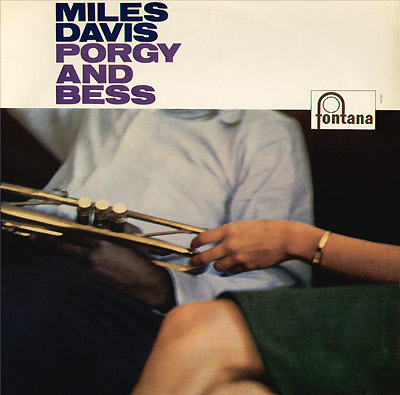
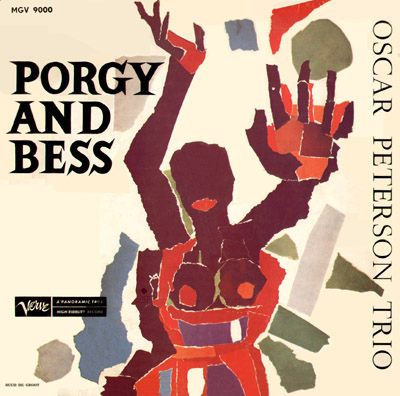
|
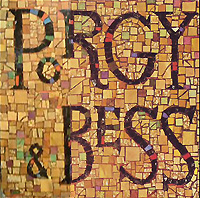
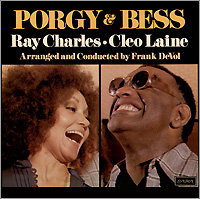
Miles
Davis and Gil Evans.
Ella Fitzgerald and Louis Armstrong. Ray Charles and Cleo Laine with Frank
DeVol (1976).
Lena Hone & Harry Belafonte on RCA with orchestras
conducted by Robert Corman and Lennie Hatmon. And Oscar Peterson with
Ray Brown (Bass) and Ed Thigpen (Drums) on a Dutch Verve release (1959),
covered in beautiful art made by Dutch artist Ruud De Groot... inspired
somewhat it seems by Ossip Zadkine?
|
| |
|
|
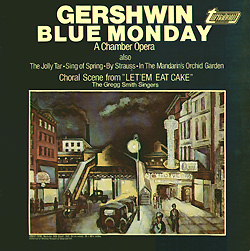
Thanks
to the Artist & Repertoire (A&R) Department of Vox Productions,
a good sample of 'Blue Monday' was already available in 1976 on Turnabout
TV 34638S.
|
A PREMONITION IN
1922
An artist's creativity, and the pinacle
of it, often has its roots in early childhood. It is a setting of the
mind, of the spirit which is mostly brought about by an occurence, a
confrontation, an event - how sudden and short and how insignificant
it may seem - that makes him realize what the path is which he will
follow, in fact is compelled to follow, and eventually will bring him
to the top of that gradually unwinding road when he creates that final
masterpiece, be it a novel, a painting, a sculpture or a musical composition.
Each and every event in the artist's life leads to the next, and always
this kernel, the thought, the idea, will be residing deep in his brain,
will be slumbering, be it subcounsciously or just as a vague notion.
'Porgy and Bess' may have begun even before Al Jolson sang Swanee, even
before George Gershwin studied harmony with Edward Kilenyi Sr., even
before him being a Tin Pan Alley song plugger, even earlier did it strike
the little boy when hearing street noise, people talking, someone singing,
the playing of a piano. Every show, every song, every musical composition
- as great as the Rhapsodies, the Concerto in F, and An American in
Paris may be - can in the end be regarded as an exercise, as a study
in music and drama, which would lead the way to 'Porgy and Bess'. Along
the road the idea often emerged in a song or a setting, and also in
a Broadway show, but most clearly in 1922 when George Gershwin wrote
BLUE MONDAY, "A Chamber Opera".
|
Blue
Monday
Orchestration, adapted from the 1925 setting of Ferde
Grofe, by Gregg Smith and Edmund Najera.
Joyce Andrews (Soprano)
Patrick Mason (Baritone)
Walter Richardson (Bass)
Thomas Bogdon (Tenor)
Jeffrey Meyer (Tenor)
The Gregg Smith Singers conducted by Gregg Smith
|
|

|
THE GERSHWINS
This is the authorative and complete
book about the Gershwins which every admirer of George Gershwin's music
and Ira Gershwin's Lyrics should own. It deals with all the musical
shows, the Rhapsody in Blue, The Concerto in F, the Second Rhapsody,
and the opera. It is written and compiled by Robert Kimball and Alfred
Simon, and places the Gershwins in the context of the period they lived
in. The book is beautifully designed by Bea Feitler. The very sympathetic
preface is written by Richard Rogers.
The book which was first published in 1973 (Bonanza Books, New York),
may have inspired many a record producer and stage director.
|
|

Quintessence
PMC-7060.
|
EARL WILD ARRANGES/IMPROVISES
Pianists and piano players find great inspiration in
the performances of the late Earl Wild (November 26, 1915 – January
23, 2010) who is not only known for his outstanding Liszt, Rachmaninoff
and Godowsky, but also for his idiomatic performances of Gershwin's
Concerto in F and Rhapsody in Blue, and for his transcriptions of Gershwin
songs and his Grand Fantasy on Airs from Porgy and Bess. Sure, virtuoso
music, but never failing to convey the essence of the moods of the various
arias.
WILLIAM
BOLCOM PLAYS JAZZBO BROWN
On Nonesuch it is pianist/composer William Bolcom who
gives a sublime rendition of Piano Playin' Jazzbo Brown (Jasbo Brown
Blues).
|

William
Bolcom on Nonesuch 32 808.
|
|
Porgy
- Willard White - Baritone
Bess - Leona Mitchell - Soprano
Crown - McHenry Boatwright - Baritone
Serena - Florence Quivar - Soprano
Clara - Barbara Hendricks - Soprano
Maria - Barbara Conrad - Mezzo-Soprano
Jake - Arthur Thompson - Baritone
Sporting Life - François Clemmons - Tenor
Mingo - James Vincent Pickens - Tenor
Robbins - Samuel Hagan - Tenor
Peter - William Brown - Tenor
Frazier - Christopher Deane - Baritone
Annie - Alpha Floyd - Mezzo-Soprano
Lily - Isola Jones - Mezzo-Soprano
Strawberry Woman - Barbara Conrad
Jim - Christopher Deane - Baritone
Undertaker - James Vincent Pickens - Tenor
Nelson - William Brown - Tenor
Crab Man - Samuel Hagan - Tenor
Mr. Archdale - John Buck
Detective - Robert Snook
Policeman - Ralph Neally
Coroner - Allan Leatherman
Scipio - Donald Zucca
Jasbo Brown - Joela Jones - piano
|
|
|
| |
DECCA and RCA
In
April 1976 Decca (London) presented this new recording which is a reference
in it own right - as the 1951 Lehman/Lieberson recording was in the
monaural years. But now with many cuts restored like the rap of Maria,
addressing Sportin' Life the morning after the death of Robbins. That
is prfobably the earliest rap performed on stage.
|
|
|

|
I hates yo' struttin' style,
Yes sir, and yo' god damn silly smile
an' yo' ten cent di'mons an yo' fi'cent butts.
Oh, I hates yo' guts.
Somebody's
got to carve you up
to set these people free.
An' de writin' on de wall says
it's goin' to be me.
Some
night when you 's full of gin
and don't know I's about,
I'm goin' to take you by de tail
an' turn you inside out.
(...)
Frien's
with you low-life
I fears I mus' decline
I sooner cuts mah own throut
'fore I calls you a frien' of mine!
|

Barbara
Conrad as Maria in the Lorin Maazel recording addressing Sportin' Life.

CLICK
HERE
|
| |
|
|
Porgy
- Donnie Ray Albert - Baritone
Bess - Clamma Dale - Soprano
Crown - Andrew Smith - Baritone
Serena - Wilma Shakesnider - Soprano
Clara - Betty Lane - Soprano
Maria - Carol Brice - Mezzo-Soprano
Jake - Alexander B. Smalls - Baritone
Sporting Life - Larry Marshall - Tenor
Mingo - Bernard Thacker - Tenor
Robbins - Glover Parham - Tenor
Peter - Mervin Wallace - Tenor
Frazier - Raymond Bazemore - Baritone
Annie - Shirley Baines - Mezzo-Soprano
Lily - Myra Merritt - Mezzo-Soprano
Strawberry Woman - Phyllis Bash
Jim - Hartwell Mace - Baritone
Undertaker - Cornel Richie - Tenor
Nelson - Steven Alex-Cole - Tenor
Crab Man - Steven Alex-Cole - Tenor
Mr. Archdale - Kenneth Barry
Detective - Hnsford Rowe
Policeman - William Gammon
Coroner - John B. Ross
Scipio - Alex Carrington
Jasbo Brown - Dick Hyman - piano |
|
RCA
released the production by the Houston Grand Opera: Children's Chorus,
Houston Grand Opera Chorus and Orchestra conducted by John DeMain. RCA
Red Seal RL02109 - 3 Lp record set.
|

Cornel
Richie, Myra Merritt, Phyllis Bash, Carol Brice and Alexander B. Smalls.
|
In
September of 1977 the RCA set - which was less sweet and gentle, yet
captivating in its rawness - was released. It claimed to be the first
original version, more so than the Decca Maazel recording. Right from
the start there were strong preferences for this or that performance
and recording. The DECCA SET may be extremely well recorded and landed
in the List of the Absolute Sound (TAS List), but there is also much
to say for the directness of the RCA recording and performance. At left
the cast. Jasbo Brown is Dick Hyman.
The
late  Marcel
Prawy, dramaturg and producer, who came to the USA in 1939 and
obtained his American citizenship in 1942, protested against the claim
by the Houston Opera and the RCA people that they had produced the first
original version. It may have been the first recording
of the original version, but not the first production of the original
version. That production was mounted in Vienna in 1965 long before RCA
and the Housten Opera Company worked together. This is what Marcel
Prawy wrote in his autobiography:
Marcel
Prawy, dramaturg and producer, who came to the USA in 1939 and
obtained his American citizenship in 1942, protested against the claim
by the Houston Opera and the RCA people that they had produced the first
original version. It may have been the first recording
of the original version, but not the first production of the original
version. That production was mounted in Vienna in 1965 long before RCA
and the Housten Opera Company worked together. This is what Marcel
Prawy wrote in his autobiography:
|

Clamma
Davis and
Donnie Ray Albert.
|

Olive
Moorefield (Bess) and William Warfield (Porgy), in the first production
of the original score of Porgy and Bess, Vienna October 19, 1965.
Image
taken from "Marcel Prawy erzählt aus seinem Leben" -
Marcel
Prawy talks about his life - Kremayr & Scheriau, Vienna, 2001.
Image
copyright Kremayr & Scheriau.
|
"I
owe a deep insight into the creativity of George Gershwin to a wonderful
man with whom I became friends in New York. There his name was Albert
Sirmai (also written as Szirmay, ed.) (...) managing director of the
famous Chappell Publishing Company and who earlier had been a close
collaborator of George Gershwin. Nearly all Gershwin's piano scores
show his name as a publisher. Countless times I have visited him after
office hours at Chapell's and did not get tired to listen to his stories
about George Gershwin. Because of his inadequate classical music studies,
Gershwin suffered from poor selfesteem, and was a Wagnerian, and Sirmai
had always to explain the technique of the 'Leitmotiv' (leading motif)
of his idol. He (Sirmai. ed.) once showed me a 'Meistersinger' opera
vocal score with Gershwin's written remarks. "Porgy" is
indeed the only opera which exists with the most 'leading motifs' ever.
The premiere performance in the year 1935 in the Alvin Theatre was no
good - except for the leading performers Todd Duncan and Anne Brown.
And when I came to America in 1939 people still said to me (...) that
Porgy, the last (composition) of Gershwin, was nothing.(...) Than they
remodeled "Porgy and Bess", inserted spoken dialog (these
are hardly present in the original), the heavy chorusses were abridged,
and changed it into a musical. That was an immense triumph in 1942.
(...) I was present. Suddenly there was a musical which had less similarity
with Gershwin's opera, but had started a triumphant tour.
I
was the first who said to director Moser of the "Volksoper":
"What in fact about the original which was never performed? As an opera
house we have all the possibilities - Gershwin never did have these.
Why don't we do that for the first time in Vienna?"
Moser agreed. And in 1965 we did produce for the first time the original
score of "Porgy and Bess", as a large, heavy opera with a
large orchestra, big chorusses, with these difficult things to sing,
for the first time in the world on October 19, 1965, at the Volksoper.
(Olive) Moorefield was Bess, William Warfield Porgy, and I was very
proud of the headline in an American newspaper: "Vienna gave Gershwin
what America did refuse him." - Marcel Prawy
|
|
| |
|
|
Porgy
- Simon Estes
Bess - Roberta Alexander
Sporting Life - Charles Williams
Crown - Gregg Baker
Clara - Marvis Martin
Jake - David Arnold
Serena - Florence Quivar
Robbins - Donald Osborne
Jasbo Brown - Joseph Joubert
Mingo - John Freeman-McDaniels
Jim - Michael Smartt
Peter, The Honey Man - Mervin Wallace
Lily - Priscilla Baskerville
Maria - Barbara Conrad
Undertaker - Milton B. Grayson, Jr.
Frazier - John D. Anthony
Scipio - Clinton Chinyelu Ingram
Strawberry Woman - Isola Jones
Crab Man - Jay Aubrey Jones
Mr. Archdale - Osie Hawkins
Detective - Larry Storch
Policeman - Andrew Murphy
Coroner - Hansford Rowe |
ETERNA - GERMAN DEMOCRATIC REPUBLIC
From
1984 is the Philips recording of highlights performed by Simon Estes
(Porgy, Sportin' Life), Roberta Alexander (Bess, Clara, Serena), Diana
Murray (Maria), the Berlin Radio Chorus, Berlin Radio Symphony Orchestra,
and conductor Leonard Slatkin. The recording was made in cooperation
with VEB Deutsche Schallplatten of the well known Eterna label from
then the German Democratic Republic (DDR). The sound of this LP and
CD have the typical and well-known open sound from ETERNA as the performances
were most certainly recorded in a church. Roberta Alexander who is well
known from her Mahler recording with Bernard Haitink and songs on the
Etcetera label, gives a fine account of "I loves you Porgy".
Philips 412 720.
METROPOLITAN
OPERA
Simon
Estes, Roberta Alexander, sung and acted with Charles Williams, Gregg
Baker, Florence Quivar in a 1985 Metropolitan production conducted by
James Levine. The list of performers is seen at left. It is a historic
performance in the sense that it was recorded more than two decades
ago on March 23rd. It is made available by  Opera-Club.net,
where downloadable complete recordings of a variety of historic and
not so historic performances are offered, from Armide to Rosenkavalier
to Porgy and Bess. They even have a recording from the 1952 European
tour with William Warfield, Leontyne Price, Cab Calloway, John McCurry,
Joseph James a.o. with the RIAS Unterhaltungs-orchester and The Eva
Jessye Chorus, Alexander Smallens conducting. The performance toolk
place in the Titania Palast, September 21, 1952.
Opera-Club.net,
where downloadable complete recordings of a variety of historic and
not so historic performances are offered, from Armide to Rosenkavalier
to Porgy and Bess. They even have a recording from the 1952 European
tour with William Warfield, Leontyne Price, Cab Calloway, John McCurry,
Joseph James a.o. with the RIAS Unterhaltungs-orchester and The Eva
Jessye Chorus, Alexander Smallens conducting. The performance toolk
place in the Titania Palast, September 21, 1952.
|


|
| |
GLYNDEBOURNE 1989
- BBC 1993
The Glyndebourne production of Porgy
& Bess with Cynthia Haymon, Cynthia Clarey, Harolyn Blackwell, Willard
White, Bruce Hubbard, Damon Evans, Gregg Baker; Johnny Worthy, Autris
Paige, Paula Ingram, Gregg Baker, Linda Thompson Williams, London Philharmonic
Orchestra, Glyndebourne Chorus, and Sir Simon Rattle, conducting, was
recorded by EMI in the Abbey Road Studios in 1988. This recording was
used as sound track for a video registration made in 1993. Two roles
were acted by different artists in this filmed version. This method
of dubbing has been used before. Famous are several sequences in the
West Side Story movie. Other examples can be seen in films produced
with Herbert von Karajan of his Berlin Philharmonic Orchestra players.
The
filmed version as well as the original Glyndebourne performance was
hailed by many who never had attended a performance of Porgy & Bess
or had not listened to other productions before. The performance was
also criticised, especially by those who had a more deepened knowledge
of the opera. Since this Porgy and Bess was a filmed performance without
the artists singing while being filmed, the intensity was not always
there. There
are of course always exceptions to the rule. Watch and listen to Willard
White and Cynthia Haymon who sing  Bess you is
my woman now on YouTube. There are instances where the synchronisation
is not always correct. (Uploaded by Courtney D. James)
Bess you is
my woman now on YouTube. There are instances where the synchronisation
is not always correct. (Uploaded by Courtney D. James)
Conductor
Simon Rattle wanted to make a mark with a showman's concept rather then
a more integer, soul searching intention. A reviewer of the performance
justly mentioned the ultra slow Summertime which misses the tension
of the expectation of the drama to come, the drama of love, life, crime,
deception and hope. Furthermore Porgy is walking around with crutches
while in the original he rides in a goat car. And when at the end he
sings I'm on My Way and goes to New York to find Bess, he throws his
crutches away and walks... a miracle has happened.
|
|
| |
|
|
|
|
Porgy
and Bess was presented by the Stardust Theatre & Impressario
in the Royal Carré Theatre in Amsterdam - April 4 till May
12, 2008, with the Orchestra and Chorus of The New York Harlem Theatre,
directed by William Barkhymer.
At left the program.
There was some critisism, but singers, musicians, director and producer
gave their best somewhat obstructed also by the rather mediocre acoustics
in the Carré Theatre which were wrongly corrected by the technicians
responsible for optimal sound. And that also prevented the public
to appreciate the performances fully.
These
performances were part of a grand tour through Europe, Russia, Japan
and Canada. Performances took place in Amsterdam, Antwerp, St, Petersburg,
Moscow, Hamburg, Dresden, Linz, etc.
|
Terry
Lee Cook - Porgy Donita Volkwijn - Bess
Cedric Cannon - Crown
Larry Marshall - Sporting Life
Alison Buchanan - Serena
Jacqueline Echols - Clara
Michael Austin - Robbins
Michael Dailey - Mingo
Marvin Scott - Peter
John Fulton - Jake
Ivan Griffin - Frazier
Marjorie Wharton - Maria |
| |
NICOLAUS HARNONCOURT
It
is impossible to mention on this page all the performances that took place
over the years. An interesting name but unexpectedly linked for once to
Gershwin´s masterpiece is that of Nicolaus Harnoncourt. He conducted
the Arnold Schoenberg Choir and the Chamber Orchestra of Europe in performances
given in Graz (Austria) to the occasion of Harnoncourt's 80th birthday.
Harnoncourt included African drums and the Arnold Schönberg Choir
had to study the Galla dialect! Main performers were Jonathan Lemalu (Porgy),
Isabelle Kabatu (Bess), and Angela Renee Simpson (Serena). Samples of
this performance can be found on  RCA.
Gershwin lovers are devided over this performance and recording. The immediate
question is: Is it Porgy & Bess with a baroque flavour or is it a
revolutionnary performance which will take the listener to the heart of
the story and the score? One thing is sure. The Harnoncourt recording
is different and it seems that the aim was to render the score in a metaculously
detailed fashion. But what is also true is that some of the soul is missing
and therefor this performance is more for the classical music oriented
person than for the lover of the authenticity of Gershwin's masterpiece
which had been so amply given in the 1951 Lehman/Lieberson production.
RCA.
Gershwin lovers are devided over this performance and recording. The immediate
question is: Is it Porgy & Bess with a baroque flavour or is it a
revolutionnary performance which will take the listener to the heart of
the story and the score? One thing is sure. The Harnoncourt recording
is different and it seems that the aim was to render the score in a metaculously
detailed fashion. But what is also true is that some of the soul is missing
and therefor this performance is more for the classical music oriented
person than for the lover of the authenticity of Gershwin's masterpiece
which had been so amply given in the 1951 Lehman/Lieberson production.
|
|
|
|
2010: 75 YEARS
OF PORGY & BESS
"To
celebrate the 75th anniversary of George Gershwin’s enduring masterpiece,
a new production of Porgy and Bess is being mounted—with
the full approval of the Gershwin estate—by veteran opera producer
Michael Capasso (General Director of New York’s vibrant Dicapo
Opera).
Porgy and Bess, featuring a stellar cast and live orchestra, will be
directed by renowned American Charles Randolph-Wright (writer
and director of the film “Mama I Want to Sing,” to be released
February 2010"), conducted by Music Director Pacien Mazzagatti,
and produced in association with Willette Murphy
Klausner. With a new orchestration by Mr. Mazzagatti, brand-new
sets designed by John Farrell, costumes by Ildikó Márta
Debreczeni, and lighting by Susan Roth, Porgy and Bess kicks
off its 26-U.S. city tour February 18, 2010 in Van Wert, Ohio."
For
a complete tour schedule see at the end of this  Press
Release.
Press
Release.
|
|
Porgy
- Leonard Rowe
Bess - Donita Volkwijn/Kishna Davis
Serena - Reyna Carguill
Crown - Phillip Boykin
Sportin’ Life - Reggie Whitehead
Maria - TBA
Jake - Eric McKeever
Mingo - Chazmond Peacock
Robbins - Taiwan Norris
Clara - Sequina DuBose
Peter - Johnny Lee Green
Lily - Natalya Simone Thomas
Annie - Ambe Williams
Strawberry Woman - Mari-Yan Pringle
Jim - Patrick Blackwell
Undertaker - Darnell Ishmel
Nelson - Sean T. Miller
Crab Man - Sean T. Miller
Funeral Solos:
Matthew Gamble - Baritone
Taleesha Janine Scott - Soprano
|
Images and more
details will eventually be added.
|
|
| |
|
|
| |
This
page will be expanded.
|
|
|
|
Text
and research Rudolf A. Bruil - Page first published February 26, 2008.
|
|



